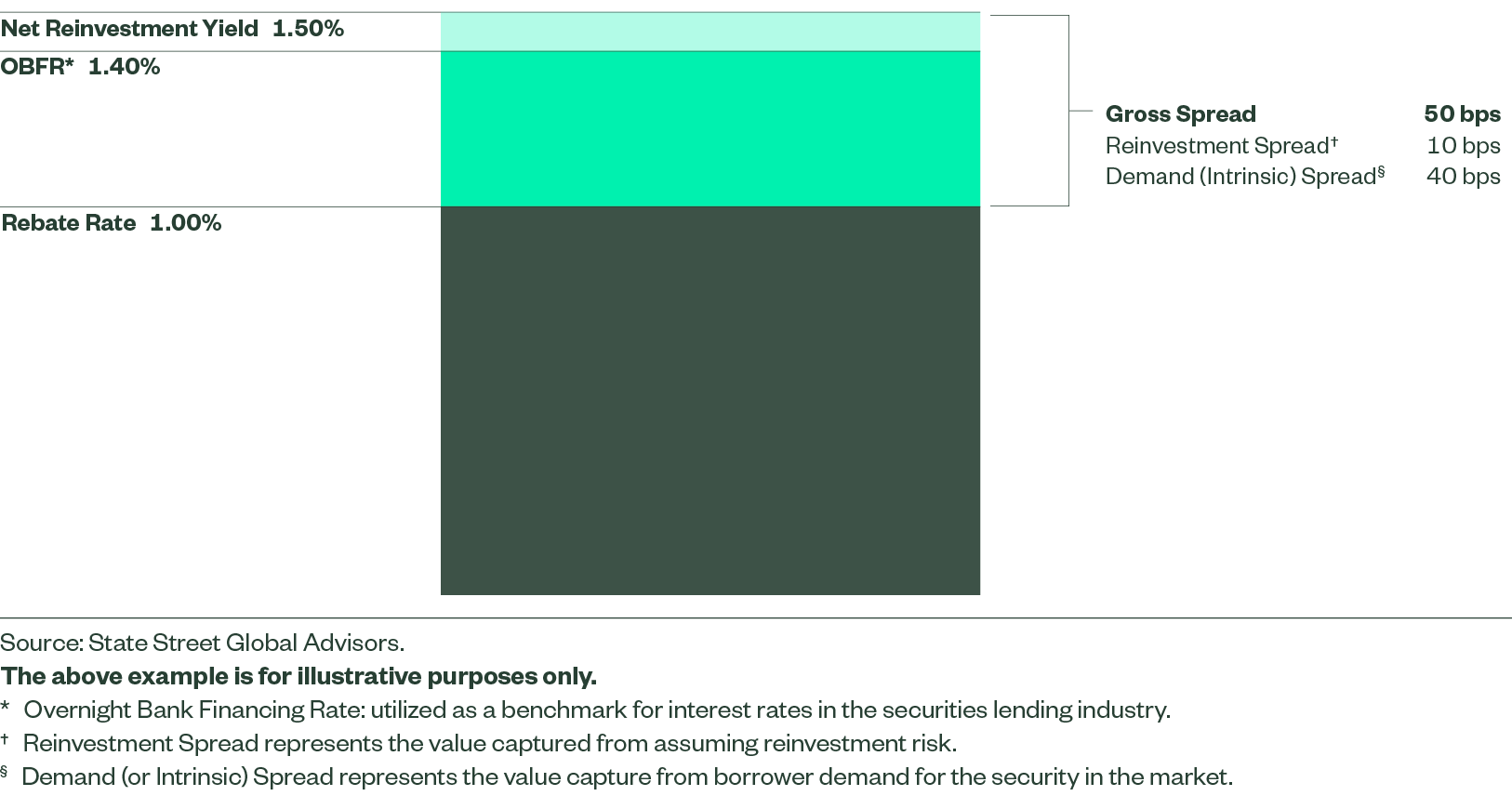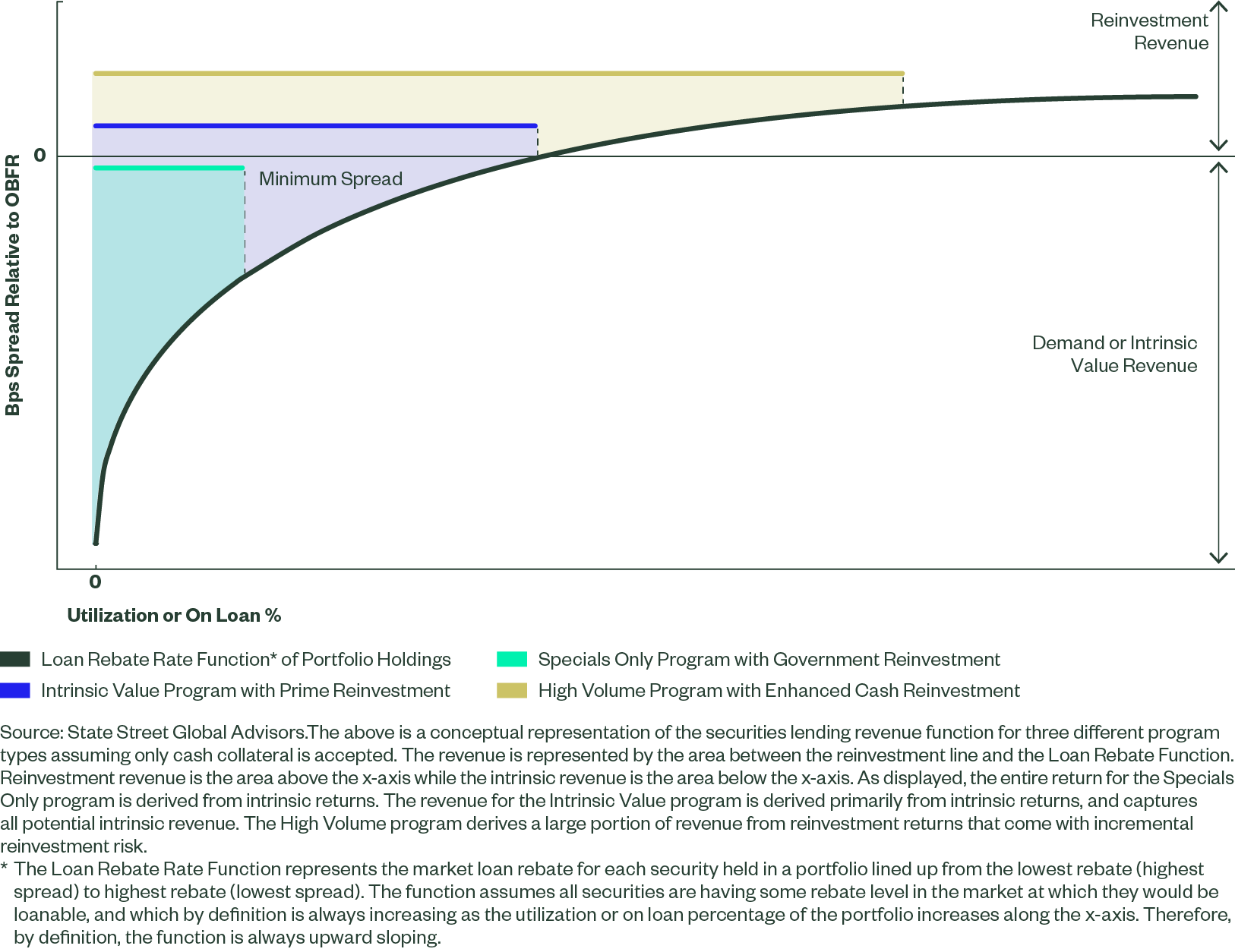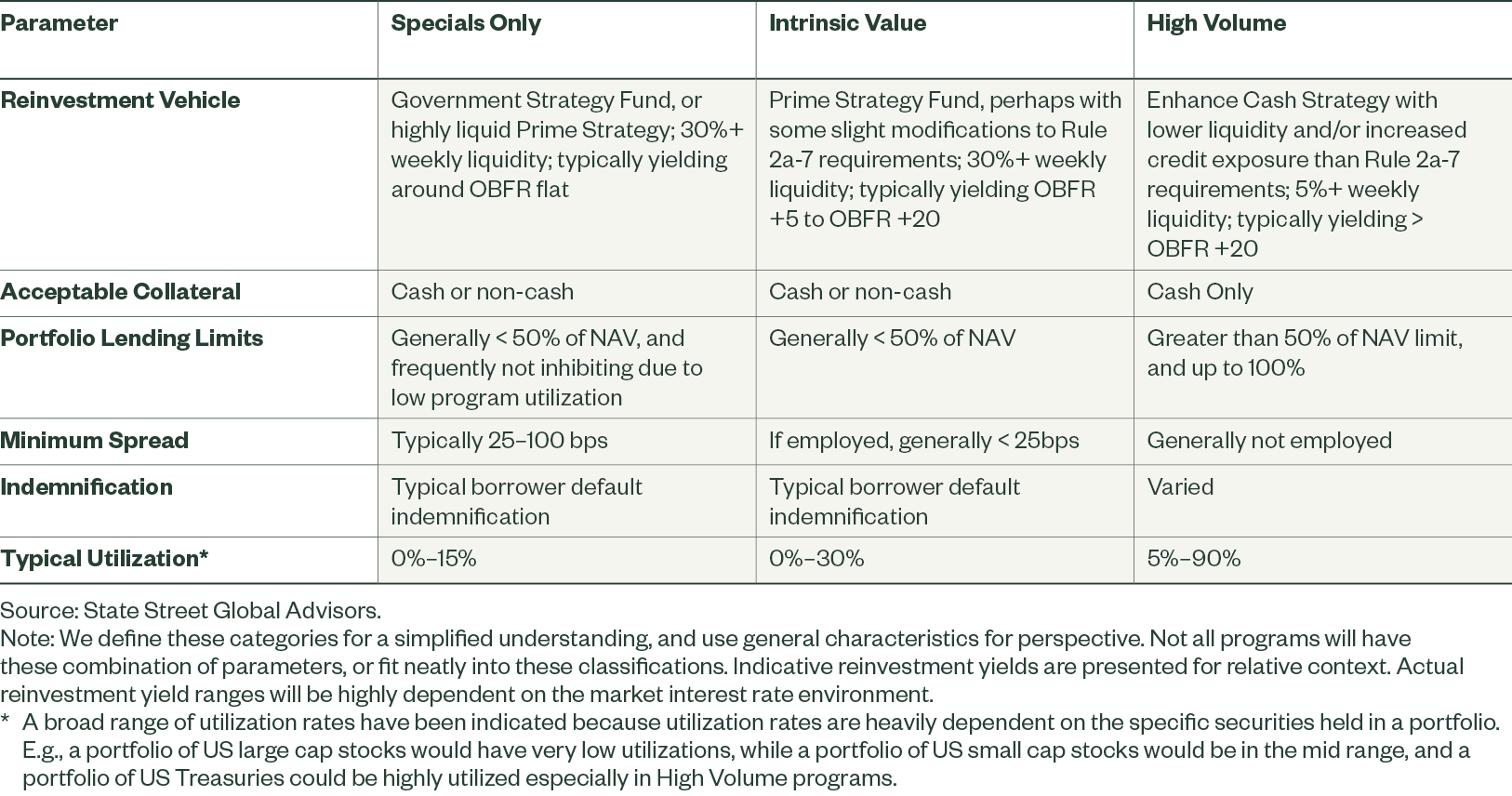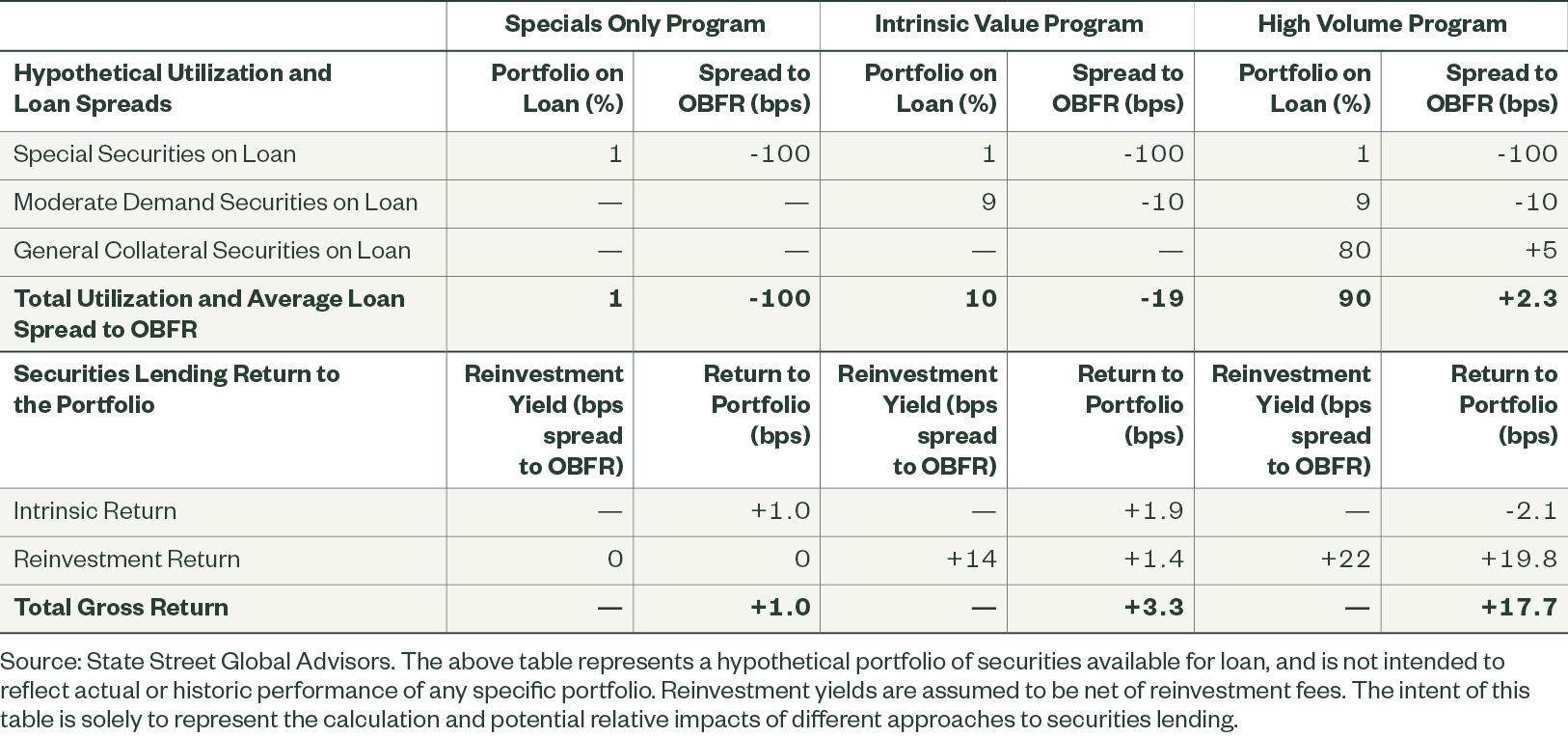An Advanced Perspective on Securities Lending
Securities lending programs have many features that can make each one unique. This paper will provide some context to help beneficial owners evaluate differences between securities lending programs, and identify the program best aligned with their risk tolerance and investment objectives.
When evaluating investment managers, the securities lending program is often an afterthought. For active investment managers, the targeted outperformance of the relevant index typically far exceeds the returns expected from securities lending. However, from a risk-adjusted perspective lending can still add value that should not be discounted.
For the evaluation of index managers the securities lending decision takes on higher importance because tracking error and fund expenses are so tight that the returns from securities lending can be a differentiating factor. That said, many beneficial owners have historically viewed the decision to lend securities as a yes/no decision, and do not fully understand the spectrum of securities lending approaches and the resulting differences in risks, returns, and fees. This paper will provide some context to help beneficial owners evaluate differences between securities lending programs, and identify the program best aligned with their risk tolerance and investment objectives.
Risk and Return
Securities lending programs have many features that can make each one unique. However, securities lending approaches generally fall on a spectrum of risk ranging from conservative to aggressive (see “Securities Lending in US DC Funds: What to Look For” for a background discussion of risks associated with securities lending). As one would expect, the differing risk levels correspond to differences in returns, whereby more risk drives higher returns. A lesser known characteristic is that fees are also frequently correlated to one’s lending approach. Frequently, higher risk and returns are correlated with higher fees. Here, we will discuss the spectrum of approaches to managing a securities lending program, the typical characteristics across the spectrum, and provide some insight regarding the relationship between risk, return, and fees.
Before we get started, it may be helpful to have an understanding of what drives risk and return in a securities lending program. For simplification, we are going to generalize return into two categories:
- Intrinsic (or Demand) Return: This is the return derived from the scarcity value of a security in the lending markets. In the case of loans collateralized by other securities (non-cash collateral), this is generally the borrow fee times the market value of the loaned security.1 In the case of securities collateralized by cash (which is common in the US markets), this is customarily calculated as the basis points (“bps”) spread between the rebate rate2 paid on the cash collateral and a risk-free rate (typically Overnight Bank Funding Rate, “OBFR” used as a proxy for the risk-free rate) times the value of collateral received. While there is risk associated with any securities loan (borrower default risk and operational risk), the risk directly associated with capturing the intrinsic return is low. Since intrinsic return can be high, we generally consider the intrinsic return of securities lending as an “Alpha Return” generator for a portfolio of securities.
- Reinvestment Return: This is the return derived from the assumption of risk in the collateral reinvestment vehicle. To the extent a securities loan is collateralized by cash, the cash is typically reinvested into a vehicle that has a profile akin to a money market fund. The reinvestment return is the basis points (bps) spread between the reinvestment yield and the risk-free rate (OBFR) times the value of collateral received. This is where the majority of risk associated with securities lending comes from, and to the extent that money markets are efficient, could be viewed as a “Beta Return” generator for the portfolio. There are arguments that money markets are not perfectly efficient, or for other reasons alpha may be generated from the reinvestment component of the securities lending equation. However, for purposes of this discussion, we will use the simplifying premise that reinvestment returns are beta returns, and the incremental return comes with an equal amount of incremental risk.
Figure 1: Components of Gross Spread on Cash Collateral Loans

Spectrum of Securities Lending Approaches
Now that we have a context of risk and return, let’s introduce the spectrum of approaches to securities lending. The conservative approach “Specials Only” lends out a small volume of securities with large intrinsic value, and typically has the lowest returns due to the low volume of loans. This approach is almost entirely focused on intrinsic value as an alpha return generator, will often have a very low reinvestment risk profile, and may also leave a portion of the intrinsic return uncaptured due to its conservative design. This type of approach may require loans to meet large minimum spread requirements in order to be entered.
Figure 2: Spectrum of Lending Approaches

An “Intrinsic Value” approach seeks to capture 100% of the intrinsic returns of securities lending, and may assume some modest reinvestment risk in that pursuit. This approach is designed to focus on maximizing the alpha returns of a securities lending program, while only assuming the beta risk necessary to achieve that objective.
The “High Volume” approach seeks to maximize total returns from securities lending. Typically, High Volume programs will have high risk/return collateral reinvestment profiles that can enable high loan volumes. High Volume programs capture the full intrinsic returns from securities lending, but also tend to have a high proportion of the returns from the reinvestment (beta) side, including loans with zero or negative intrinsic value. High Volume programs typically avoid non-cash collateral loans as they do not enable reinvestment returns that drive the overall program returns.
Figure 3: Conceptual Securities Lending Revenue Functions

Each securities lending approach is actually a compilation of various design criteria for a securities lending program and exists on a spectrum as opposed to distinct categories. For ease of comparison we generalize into the three categories outlined in Figure 2. Securities lending programs have numerous parameters that can affect their ultimate risk and return such as lending limits, approved borrowers, acceptable collateral types, margin requirements, indemnification clauses, and minimum spread criteria (see Figure 4). However, the primary driver of the risk-return profile is typically the risk associated with the cash collateral reinvestment vehicle, and the amount of a portfolio that is on loan (also called utilization) against cash collateral. Note that even if a minimum spread criteria is not explicitly stated in the program parameters, it is implicit as the agent lender is not incentivized to enter loans when the revenue from the loan would not meet their costs for issuing and maintaining it. However, to assure this, or to restrict lending beyond the level of profitability to the lending agent, minimum spreads can be applied as desired by the portfolio owner. Below is a chart of typical program characteristics by approach.
Figure 4: Program Characteristics by Approach

Reinvestment Risk
As discussed above, risk in a lending program largely comes from the reinvestment of cash collateral. While non-cash collateral loans avoid this risk entirely, cash collateral loans must bear reinvestment risk. This can be considered from both a price perspective and also a liquidity perspective, and is further magnified by the volume of cash collateral received relative to the portfolio size. For example, a Specials Only program typically has a cash collateral reinvestment vehicle with excellent price stability and liquidity (e.g., a Government Money Market Fund). Also, with only a small portion of securities on loan, the exposure to the reinvestment vehicle is small. An Intrinsic Value program utilizing a Prime Strategy reinvestment vehicle that follows Rule 2a-73 guidelines generally has moderate price risk, and the liquidity requirements of Rule 2a-7 keep it sufficiently liquid. This enables larger volumes of loans than Specials Only programs. Hence, exposure to the reinvestment vehicle in an Intrinsic Value program is moderately increased as compared to the Specials Only program, but the exposure is still to a vehicle with only moderate price and liquidity risk. High Volume programs typically use enhanced cash strategies, which frequently utilize term repurchase agreement (repo) trades to enhance their yields.
Term repo has very good price stability, but sacrifices liquidity in order to enhance yield. When combined with relatively high utilizations, this can result in higher exposure to a partially illiquid vehicle.
It should be noted that reinvestment risks are difficult to evaluate using traditional risk evaluation methods such as Value at Risk, etc. This is because the risk is generally dormant until extremely stressed situations arise, and hence can operate for years or even decades without a risk event materializing (i.e. tail risk). When these risks do materialize however, the impact can vary significantly for securities lending programs with different approaches.
Returns
Owing to the relationship between risk and return in different approaches to securities lending, approaches with different risk profiles will also exhibit returns that vary significantly. Using an example of a diverse US Treasury fund enrolled in securities lending, we can examine how the fund’s risk profile and approach impact the resulting returns.
If that fund employs the Specials Only program, it is likely to only loan securities trading special in the market, such as a current 10 year Treasury note, which may be loaned at rebates of 100 bps under OBFR. In this scenario, we assume a utilization rate of 1% for the portfolio, which results in a small percentage of the portfolio on loan, but at a high spread. Alternatively, an Intrinsic Value program would lend the same special securities, but also lend all securities that have modest demand in the market at a rebate rate of 10 bps under OBFR. For explanatory purposes, we will assume these loans constitute 9% of the portfolio. Lastly, a High Volume program would lend all the same securities as the Intrinsic Value program, but also lend 80%, or most of the rest, of the portfolio of US Treasuries at 5 bps over OBFR. Figure 5 helps to illustrate how these different approaches impact the gross securities lending returns.
Figure 5: How These Different Approaches Impact the Gross Securities Lending Returns

Notice that while the returns have increased under the different lending approaches, the driver of the returns is also changing. For the Specials Only and Intrinsic Value approaches, the majority of returns are alpha returns derived from the intrinsic (or demand) side of the equation. For the High Volume program, the returns are overwhelmingly driven by beta returns from the reinvestment side of the equation. Reinvestment returns carry corresponding reinvestment risk. As we discussed, this example demonstrates that the Specials Only programs seek to minimize reinvestment risk and returns, the Intrinsic Value programs seek to maximize alpha or intrinsic returns, and the High Volume programs seek to maximize total returns while assuming the most risk.
To be clear, no particular approach to lending is right or wrong. Rather, an investor should know what type of program their funds participate in, where the returns come from, and whether they and their stakeholders are comfortable with the associated risks.
Fees
Fees in securities lending can also be confusing. Many investors can be lulled into a perception that they are getting a better deal with a lower fee split, but this is not always the case. There are two primary fees to consider in a securities lending program: the fee split, and expenses associated with the fund used for reinvestment of cash collateral. Some programs may add operational or administrative fees as well, but that is not as common.
Similar to risk and return, the fees of a securities lending program fall on a spectrum, and are often correlated to the approach to securities lending employed. This is because some of the costs of running the lending program for the lending agent are driven by the volume of securities on loan. Also, fee splits are a percentage of the gross spread earned on a securities loan. This means that higher volume programs are more costly to execute overall, and conversely programs with lower utilization and higher spread loans can have a larger cost per dollar on loan to investors despite the lower fee split. Let’s take the framework from the returns example in Figure 5 to demonstrate how the fee split works for different approaches.
As is evident in Figure 6, despite the Specials Only program having a better fee split of 90% to the fund and 10% to the Agent, it actually has a similar Agent Lender fee in terms of the basis points per dollar on loan relative to the Intrinsic Value program at a 70%/30% fee split and the High Volume program at a 50%/50% fee split. While conservative lending programs typically have lower fee splits to the lending agent, and more aggressive programs typically have higher fee splits, this does not necessarily suggest one or the other is a better deal or less expensive; rather, one should consider the impact to the risk-return profile of the program after the fee impact, particularly in light of the fact that the investor typically bears the reinvestment risk entirely.
Figure 6: How the Fee Split Works for Different Approaches

In Figure 6, the High Volume program returns 8.9 bps to the fund, but the fund is assuming 100% of the reinvestment risk with relatively high volume and more aggressive risk parameters in the reinvestment fund. On the contrary, the Specials Only program is receiving 0.9 bps return and assuming negligible reinvestment risk. It is worth noting here that the Intrinsic Value program shows a 2.3 bps return, but maximizes the return derived from intrinsic value, the alpha return generator in securities lending. Therefore, it is not uncommon for programs with fee splits more favorable to the lending agent also have the highest returns to the lending fund net of fees, but one should be aware of where the returns are coming from, intrinsic returns or reinvestment returns.
Further, a fee that receives less focus than the headline “fee split,” but should not be ignored, is the cost associated with the collateral reinvestment vehicle. For a Specials Only program, this fee is frequently small relative to the revenue of the program, owing to the low utilization and high intrinsic spreads. At the other end of the spectrum, for High Volume programs, the collateral reinvestment expenses can be substantially larger, and even exceed the fees paid on the “fee split.” Not only are the reinvestment expenses important to factor into your evaluation, they can distort the risk/return profile of the program. This is driven by the fact that typically 100% of the reinvestment risk is borne by the lending fund, but the incremental yield is shared with the lending agent and reinvestment manager through the fee split and investment management fees on the reinvestment vehicle. In an evaluation of fees, the investment management fees of the reinvestment vehicle should be added to the fees associated with the fee split in order to obtain a full picture of the expenses associated with securities lending. This can be tricky because they are expressed in different forms (percentage of revenue and basis points on cash balances, respectively). While it can be complicated, one approach to normalization would be to convert both to a basis points return for on loan balances.
The Bottom Line
Securities lending can be a valuable source of incremental revenue to a beneficial owner, and while many beneficial owners focus on the decision of whether to enroll in a lending program, fewer focus on the different approaches to lending despite the fact that the differences in the risk-return profile can be substantial. Once a decision to participate in securities lending has been made, it is important to consider the different approaches available and whether the approach employed aligns with the beneficial owner’s risk tolerances.
Further, fees for securities lending are not readily comparable across different approaches. While the fee split appears easy to compare, the actual cost in relation to value on loan requires more analysis and should include consideration of the reinvestment vehicle expenses. This is particularly important because while the beneficial owner typically bears the full risk of the reinvestment exposure, they often share the returns with the lending agent and reinvestment manager who do not bear the corresponding risk. Additionally, while borrower default indemnification covers losses attributable to a borrower default, it does not cover the risks associated with the investment profile of the collateral reinvestment fund.
We reiterate here, that there is not one right or wrong approach to securities lending, and the risk-return-fee profile that suits one beneficial owner may not be appropriate for another. In fact, perspectives on the amount of risk in the reinvestment vehicle may differ between beneficial owners. Further, recognizing the risk associated with securities lending is different than the risk inherent in the underlying portfolio being lent, and a willingness to introduce a different sort of risk and to differing orders of magnitude could vary between beneficial owners based on their specific risk tolerances.